Extraction of Irrigation Signals by Using SMAP Soil Moisture Data
Abstract
1. Introduction
2. Basic Idea
3. Study Area and Datasets
3.1. Study Area
3.2. Datasets
3.2.1. Soil Moisture Datasets
(1) SMAP L3 Passive Soil Moisture Product
(2) In situ Soil Moisture
3.2.2. Daily Precipitation Dataset
3.2.3. Auxiliary Datasets
4. Methodology
4.1. Extraction of Soil Moisture Increased Stage
4.2. Construction of Fuzzy Membership Functions with which to Formulate the Relationship between Irrigation Necessity and Environmental Factors
(1) Fuzzy membership function for irrigation necessity with respect to soil moisture
(2) Fuzzy membership function for irrigation necessity with respect to precipitation
(3) Fuzzy membership function for irrigation necessity with respect to other factors
4.3. Relevant Degree between Increased Soil Moisture and Irrigation
4.4. Method of Validating Extracted Irrigation Signals
5. Results
5.1. Validation of the Extracted Irrigation Signals
5.2. Irrigation Frequency in Henan Province
5.3. Spatial Analysis of the Irrigation Frequency Map
6. Discussion
7. Conclusions
Author Contributions
Funding
Institutional Review Board Statement
Informed Consent Statement
Data Availability Statement
Conflicts of Interest
References
- Siebert, S.; Doll, P.; Hoogeveen, J.; Faures, J.M.; Frenken, K.; Feick, S. Development and validation of the global map of irrigation areas. Hydrol. Earth Syst. Sci. 2005, 9, 535–547. [Google Scholar] [CrossRef]
- Godfray, H.C.J.; Beddington, J.R.; Crute, I.R.; Haddad, L.; Lawrence, D.; Muir, J.F.; Pretty, J.; Robinson, S.; Thomas, S.M.; Toulmin, C. Food Security: The Challenge of Feeding 9 Billion People. Science 2010, 327, 812–818. [Google Scholar] [CrossRef] [PubMed]
- Troy, T.J.; Kipgen, C.; Pal, I. The impact of climate extremes and irrigation on US crop yields. Environ. Res. Lett. 2015, 10, 054013. [Google Scholar] [CrossRef]
- Zhang, C.; Liu, J.G.; Shang, J.L.; Cai, H.J. Capability of crop water content for revealing variability of winter wheat grain yield and soil moisture under limited irrigation. Sci. Total Environ. 2018, 631–632, 677–687. [Google Scholar] [CrossRef]
- Lobell, D.B.; Bonfils, C. The effect of irrigation on regional temperatures: A spatial and temporal analysis of trends in California, 1934–2002. J. Clim. 2008, 21, 2063–2071. [Google Scholar] [CrossRef]
- Leng, G.Y.; Huang, M.Y.; Tang, Q.H.; Leung, L.R. A modeling study of irrigation effects on global surface water and groundwater resources under a changing climate. J. Adv. Model. Earth Syst. 2015, 7, 1285–1304. [Google Scholar] [CrossRef]
- Tang, Q.; Rosenberg, E.A.; Lettenmaier, D.P. Use of satellite data to assess the impacts of irrigation withdrawals on Upper Klamath Lake, Oregon. Hydrol. Earth Syst. Sci. 2009, 13, 617–627. [Google Scholar] [CrossRef]
- Nazemi, A.; Wheater, H.S. On inclusion of water resource management in Earth system models—Part 2: Representation of water supply and allocation and opportunities for improved modeling. Hydrol. Earth Syst. Sci. 2015, 19, 63–90. [Google Scholar] [CrossRef]
- Nazemi, A.; Wheater, H.S. On inclusion of water resource management in Earth system models—Part 1: Problem definition and representation of water demand. Hydrol. Earth Syst. Sci. 2015, 19, 33–61. [Google Scholar] [CrossRef]
- Elliott, J.; Deryng, D.; Mueller, C.; Frieler, K.; Konzmann, M.; Gerten, D.; Glotter, M.; Floerke, M.; Wada, Y.; Best, N.; et al. Constraints and potentials of future irrigation water availability on agricultural production under climate change. Proc. Natl. Acad. Sci. USA 2014, 111, 3239–3244. [Google Scholar] [CrossRef] [PubMed]
- Kang, S.; Eltahir, E.A.B. North China Plain threatened by deadly heatwaves due to climate change and irrigation. Nat. Commun. 2018, 9, 2894. [Google Scholar] [CrossRef]
- Portmann, F.T.; Siebert, S.; Döll, P. MIRCA2000—Global monthly irrigated and rainfed crop areas around the year 2000: A new high-resolution data set for agricultural and hydrological modeling. Glob. Biogeochem. Cycles 2010, 24, GB1011. [Google Scholar] [CrossRef]
- Ozdogan, M. Exploring the potential contribution of irrigation to global agricultural primary productivity. Glob. Biogeochem. Cycles 2011, 25, B3016. [Google Scholar] [CrossRef]
- Foster, T.; Mieno, T.; Brozovi, T. Satellite-based Monitoring of Irrigation Water Use: Assessing Measurement Errors and Their Implications for Agricultural Water Management Policy. Water Resour. Res. 2020, 56, e2020WR028378. [Google Scholar] [CrossRef]
- Ozdogan, M.; Gutman, G. A new methodology to map irrigated areas using multi-temporal MODIS and ancillary data: An application example in the continental US. Remote Sens. Environ. 2008, 112, 3520–3537. [Google Scholar] [CrossRef]
- Thenkabail, P.S.; Biradar, C.M.; Noojipady, P.; Dheeravath, V.; Li, Y.J.; Velpuri, M.; Gumma, M.; Gangalakunta, O.R.P.; Turral, H.; Cai, X.L.; et al. Global irrigated area map (GIAM), derived from remote sensing, for the end of the last millennium. Int. J. Remote Sens. 2009, 30, 3679–3733. [Google Scholar] [CrossRef]
- Pervez, M.S.; Budde, M.; Rowland, J. Mapping irrigated areas in Afghanistan over the past decade using MODIS NDVI. Remote Sens. Environ. 2014, 149, 155–165. [Google Scholar] [CrossRef]
- Chen, Y.; Lu, D.; Luo, L.; Pokhrel, Y.; Deb, K.; Huang, J.; Ran, Y. Detecting irrigation extent, frequency, and timing in a heterogeneous arid agricultural region using MODIS time series, Landsat imagery, and ancillary data. Remote Sens. Environ. 2017. [Google Scholar] [CrossRef]
- Xiao, X.; Boles, S.; Liu, J.; Zhuang, D.; Frolking, S.; Li, C.; Salas, W.; Iii, B.M. Mapping paddy rice agriculture in southern China using multi-temporal MODIS images. Remote Sens. Environ. 2005, 95, 480–492. [Google Scholar] [CrossRef]
- Pena-Arancibia, J.L.; McVicar, T.R.; Paydar, Z.; Li, L.T.; Guerschman, J.P.; Donohue, R.J.; Dutta, D.; Podger, G.M.; van Dijk, A.; Chiew, F.H.S. Dynamic identification of summer cropping irrigated areas in a large basin experiencing extreme climatic variability. Remote Sens. Environ. 2014, 154, 139–152. [Google Scholar] [CrossRef]
- Kolassa, J.; Gentine, P.; Prigent, C.; Aires, F.; Alemohammad, S.H. Soil moisture retrieval from AMSR-E and ASCAT microwave observation synergy. Part 2: Product evaluation. Remote Sens. Environ. 2017, 195, 202–217. [Google Scholar] [CrossRef]
- Kerr, Y.H.; Al-Yaari, A.; Rodriguez-Fernandez, N.; Parrens, M.; Molero, B.; Leroux, D.; Bircher, S.; Mahmoodi, A.; Mialon, A.; Richaume, P.; et al. Overview of SMOS performance in terms of global soil moisture monitoring after six years in operation. Remote Sens. Environ. 2016, 180, 40–63. [Google Scholar] [CrossRef]
- Pan, M.; Cai, X.T.; Chaney, N.W.; Entekhabi, D.; Wood, E.F. An initial assessment of SMAP soil moisture retrievals using high-resolution model simulations and in situ observations. Geophys. Res. Lett. 2016, 43, 9662–9668. [Google Scholar] [CrossRef]
- An, R.; Zhang, L.; Wang, Z.; Quaye-Ballard, J.A.; You, J.J.; Shen, X.J.; Gao, W.; Huang, L.J.; Zhao, Y.H.; Ke, Z.Y. Validation of the ESA CCI soil moisture product in China. Int. J. Appl. Earth Obs. Geoinf. 2016, 48, 28–36. [Google Scholar] [CrossRef]
- Kumar, S.V.; Peters-Lidard, C.D.; Santanello, J.A.; Reichle, R.H.; Draper, C.S.; Koster, R.D.; Nearing, G.; Jasinski, M.F. Evaluating the utility of satellite soil moisture retrievals over irrigated areas and the ability of land data assimilation methods to correct for unmodeled processes. Hydrol. Earth Syst. Sci. 2015, 19, 4463–4478. [Google Scholar] [CrossRef]
- Qiu, J.X.; Gao, Q.Z.; Wang, S.; Su, Z.R. Comparison of temporal trends from multiple soil moisture data sets and precipitation: The implication of irrigation on regional soil moisture trend. Int. J. Appl. Earth Obs. Geoinf. 2016, 48, 17–27. [Google Scholar] [CrossRef]
- Singh, D.; Gupta, P.K.; Pradhan, R.; Dubey, A.K.; Singh, R.P. Discerning shifting irrigation practices from passive microwave radiometry over Punjab and Haryana. J. Water Clim. Chang. 2017, 8, 303–319. [Google Scholar] [CrossRef]
- Lawston, P.M.; Santanello, J.A.; Kumar, S.V. Irrigation Signals Detected From SMAP Soil Moisture Retrievals. Geophys. Res. Lett. 2017, 44, 11860–11867. [Google Scholar] [CrossRef]
- Brocca, L.; Tarpanelli, A.; Filippucci, P.; Dorigo, W.; Zaussinger, F.; Gruber, A.; Fernandez-Prieto, D. How much water is used for irrigation? A new approach exploiting coarse resolution satellite soil moisture products. Int. J. Appl. Earth Obs. Geoinf. 2018, 73, 752–766. [Google Scholar] [CrossRef]
- Jalilvand, E.; Tajrishy, M.; Hashemi, S.; Brocca, L. Quantification of irrigation water using remote sensing of soil moisture in a semi-arid region. Remote Sens. Environ. 2019, 231, 111226. [Google Scholar] [CrossRef]
- Zaussinger, F.; Dorigo, W.; Gruber, A.; Tarpanelli, A.; Filippucci, P.; Brocca, L. Estimating irrigation water use over the contiguous United States by combining satellite and reanalysis soil moisture data. Hydrol. Earth Syst. Sci. 2019, 23, 897–923. [Google Scholar] [CrossRef]
- Al-Yaari, A.; Ducharne, A.; Cheruy, F.; Crow, W.T.; Wigneron, J.P. Satellite-based soil moisture provides missing link between summertime precipitation and surface temperature biases in CMIP5 simulations over conterminous United States. Sci. Rep. 2019, 9, 1657. [Google Scholar] [CrossRef]
- Hao, Z.; Zhao, H.L.; Zhang, C.; Wang, H.; Jiang, Y.Z. Detecting Winter Wheat Irrigation Signals Using SMAP Gridded Soil Moisture Data. Remote Sens. 2019, 11, 2390. [Google Scholar] [CrossRef]
- Zadeh, L.A. Fuzzy sets. Fuzzy Sets, Fuzzy Logic, & Fuzzy Systems; World Scientific Publishing Co., Inc.: New York, NY, USA, 1996; pp. 394–432. [Google Scholar]
- Zhu, A. A personal construct-based knowledge acquisition process for natural resource mapping. Int. J. Geogr. Inf. Syst. 1999, 13, 119–141. [Google Scholar] [CrossRef]
- Zhu, A.X.; Hudson, B.; Burt, J.; Lubich, K.; Simonson, D. Soil mapping using GIS, expert knowledge, and fuzzy logic. Soil Sci. Soc. Am. J. 2001, 65, 1463–1472. [Google Scholar] [CrossRef]
- Zhu, L.; Liu, J.; Zhu, A.X.; Sheng, M.; Duan, Z. Spatial Distribution of Diurnal Rainfall Variation in Summer over China. J. Hydrometeorol. 2018, 19, 667–678. [Google Scholar] [CrossRef]
- Zhang, X.F.; Zhang, T.T.; Zhou, P.; Shao, Y.; Gao, S. Validation Analysis of SMAP and AMSR2 Soil Moisture Products over the United States Using Ground-Based Measurements. Remote Sens. 2017, 9, 104. [Google Scholar] [CrossRef]
- Cui, H.Z.; Jiang, L.M.; Du, J.Y.; Zhao, S.J.; Wang, G.X.; Lu, Z.; Wang, J. Evaluation and analysis of AMSR-2, SMOS, and SMAP soil moisture products in the Genhe area of China. J. Geophys. Res. Atmos. 2017, 122, 8650–8666. [Google Scholar] [CrossRef]
- Kim, H.; Parinussa, R.; Konings, A.G.; Wagner, W.; Cosh, M.H.; Lakshmi, V.; Zohaib, M.; Choi, M. Global-scale assessment and combination of SMAP with ASCAT (active) and AMSR2 (passive) soil moisture products. Remote Sens. Environ. 2018, 204, 260–275. [Google Scholar] [CrossRef]
- Zhu, L.M.; Liu, J.Z.; Zhu, A.X.; Duan, Z. Spatial evaluation of L-band satellite-based soil moisture products in the upper Huai River basin of China. Eur. J. Remote Sens. 2019, 52, 194–205. [Google Scholar] [CrossRef]
- Colliander, A.; Jackson, T.J.; Bindlish, R.; Chan, S.; Das, N.; Kim, S.B.; Cosh, M.H.; Dunbar, R.S.; Dang, L.; Pashaian, L.; et al. Validation of SMAP surface soil moisture products with core validation sites. Remote Sens. Environ. 2017, 191, 215–231. [Google Scholar] [CrossRef]
- Shen, Y.; Zhao, P.; Pan, Y.; Yu, J.J. A high spatiotemporal gauge-satellite merged precipitation analysis over China. J. Geophys. Res. Atmos. 2014, 119, 3063–3075. [Google Scholar] [CrossRef]
- Brocca, L.; Ciabatta, L.; Massari, C.; Moramarco, T.; Hahn, S.; Hasenauer, S.; Kidd, R.; Dorigo, W.; Wagner, W.; Levizzani, V. Soil as a natural rain gauge: Estimating global rainfall from satellite soil moisture data. J. Geophys. Res. Atmos. 2014, 119, 5128–5141. [Google Scholar] [CrossRef]
- Zhu, A.; Lin, Y.; Li, B.L.; Qin, C.Z.; Tao, P.; Liu, B.Y.; Minasny, B.; Lark, M.; Behrens, T. Construction of membership functions for predictive soil mapping under fuzzy logic. Geoderma 2010, 155, 164–174. [Google Scholar] [CrossRef]
- ORNL DAAC. Spatial Data Access Tool (SDAT); ORNL DAAC: Oak Ridge, TN, USA, 2017. [Google Scholar] [CrossRef]

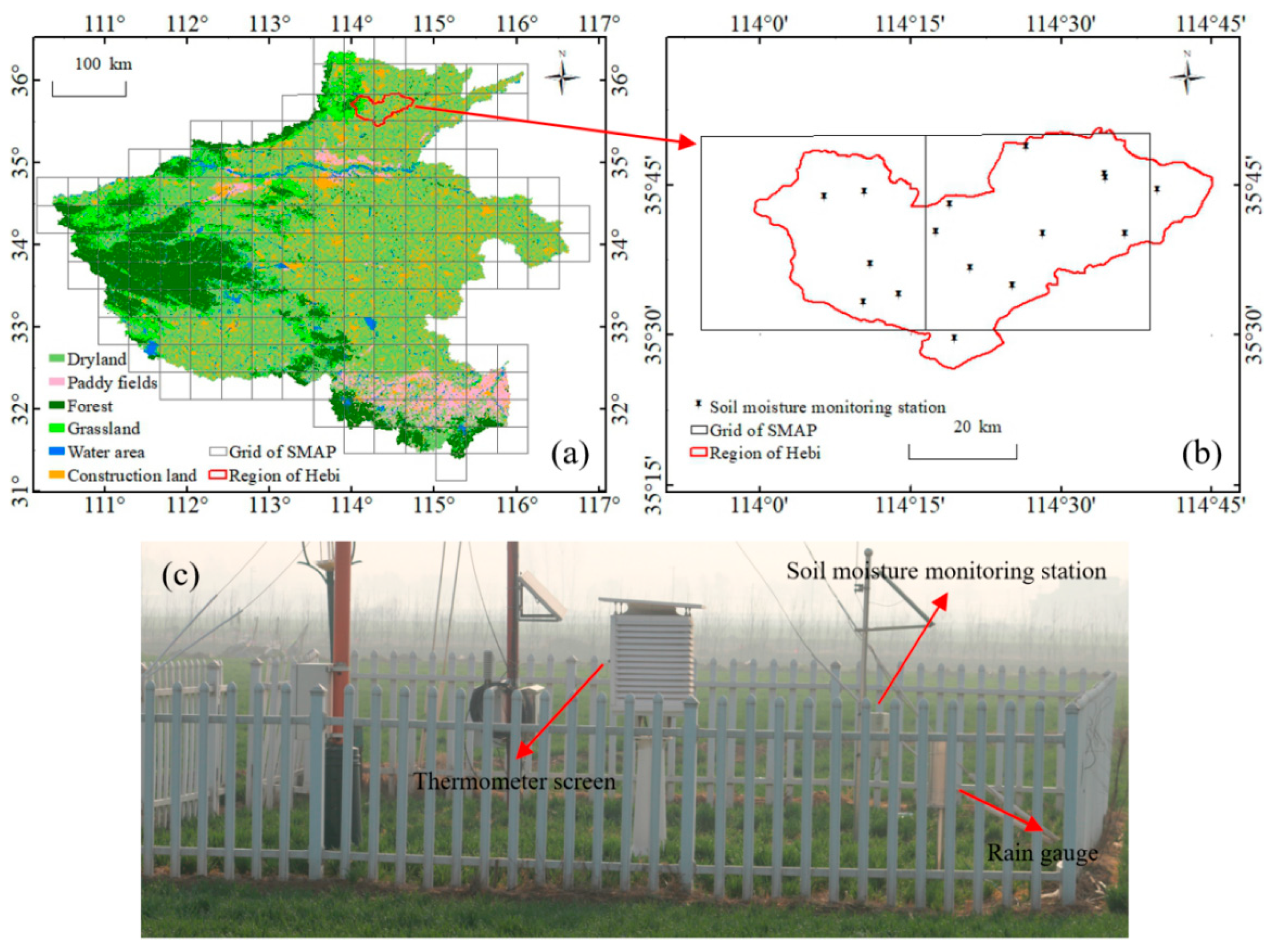
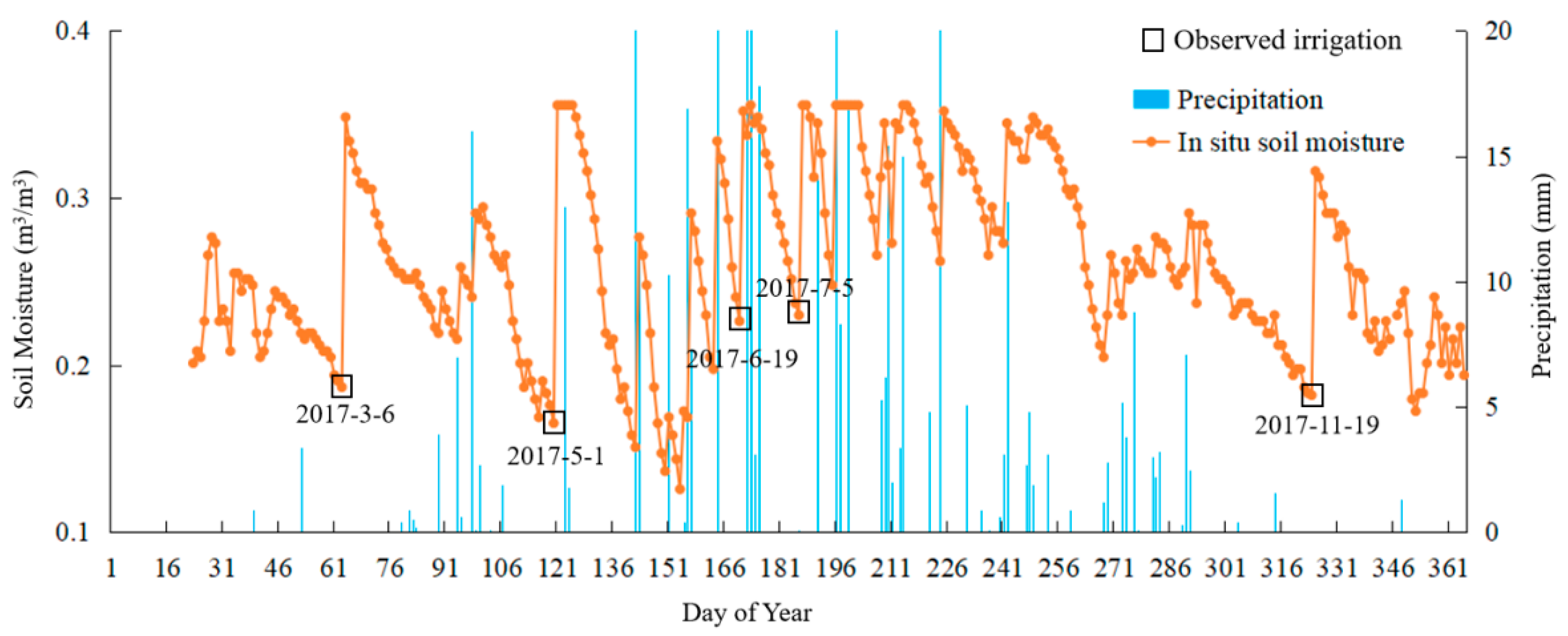
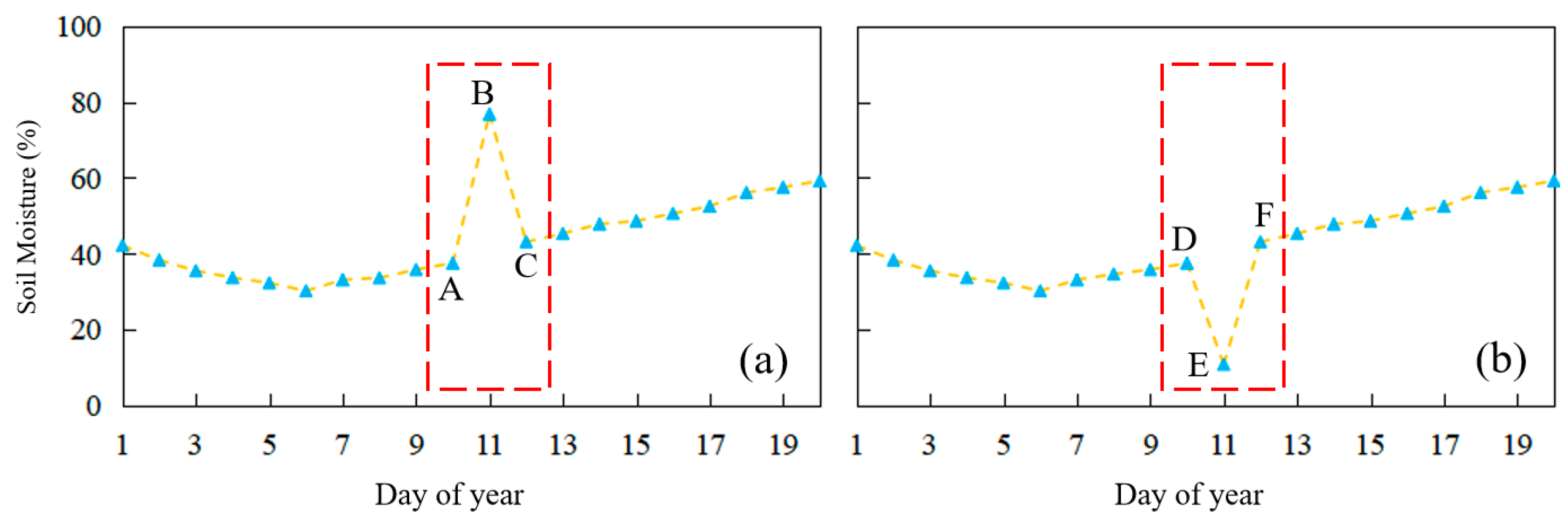
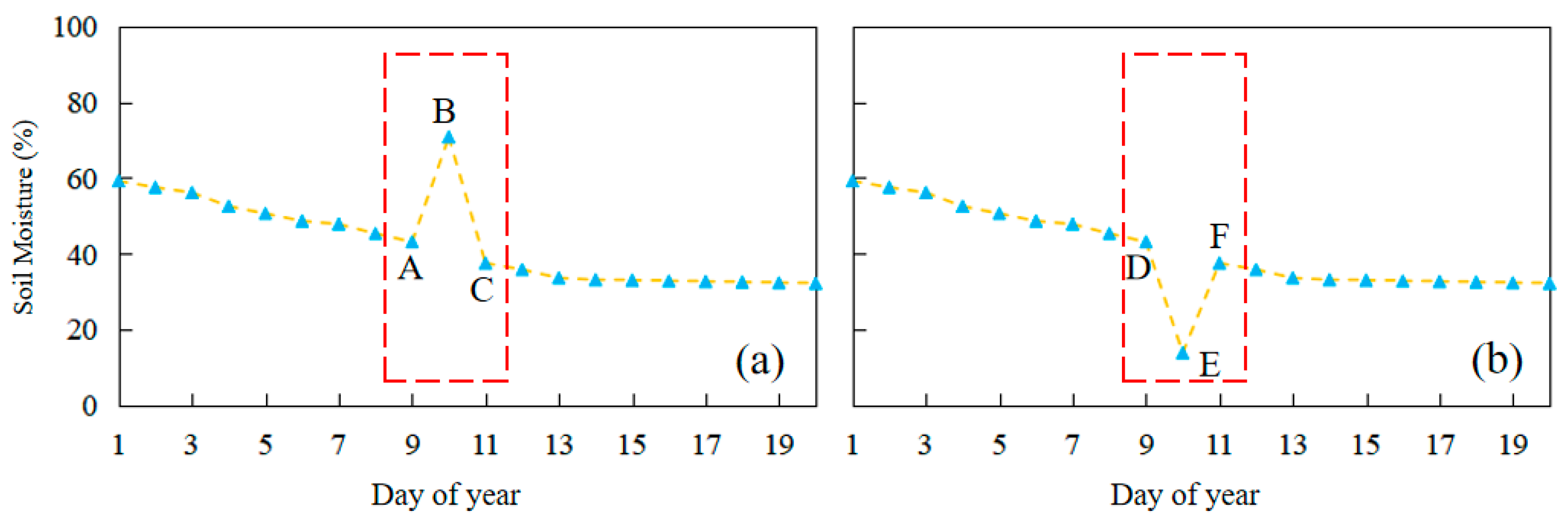
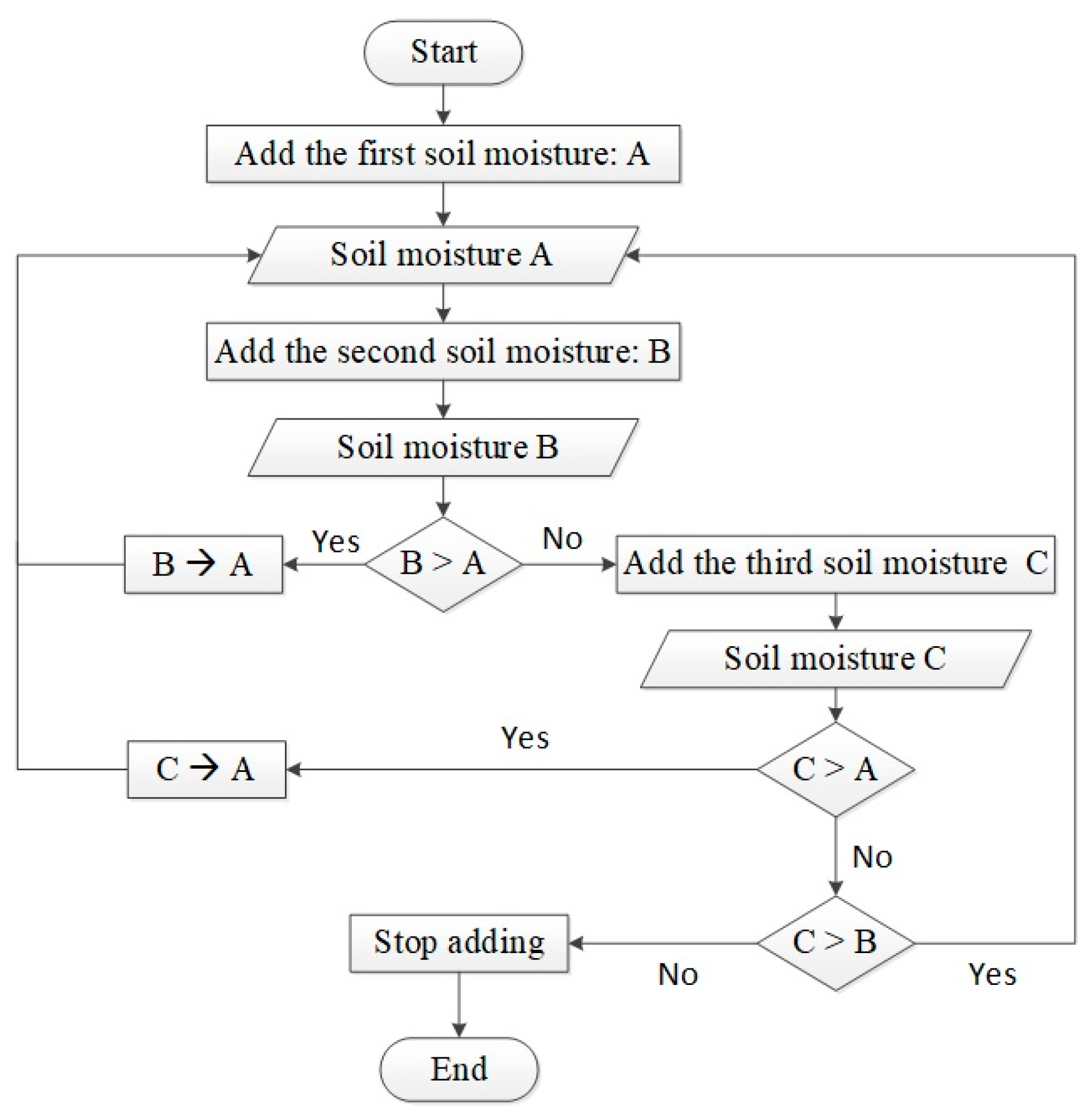
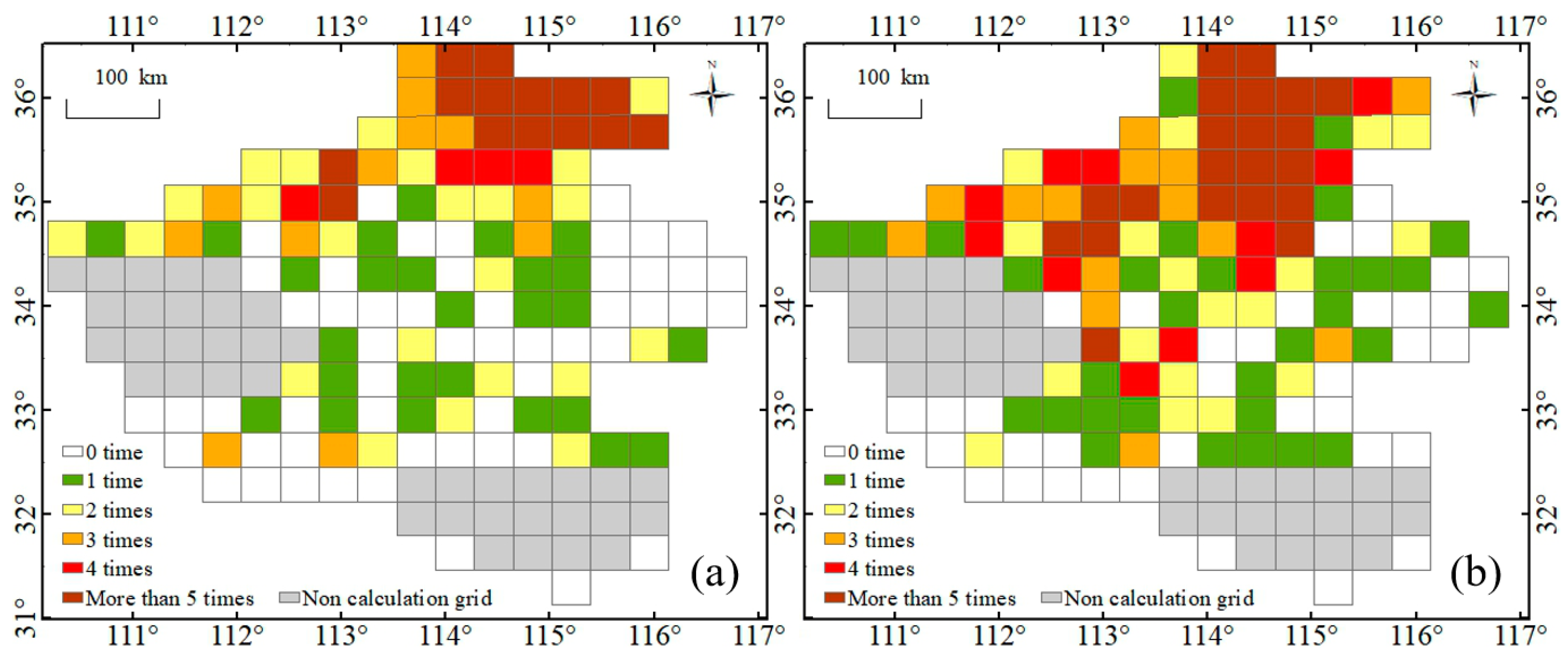
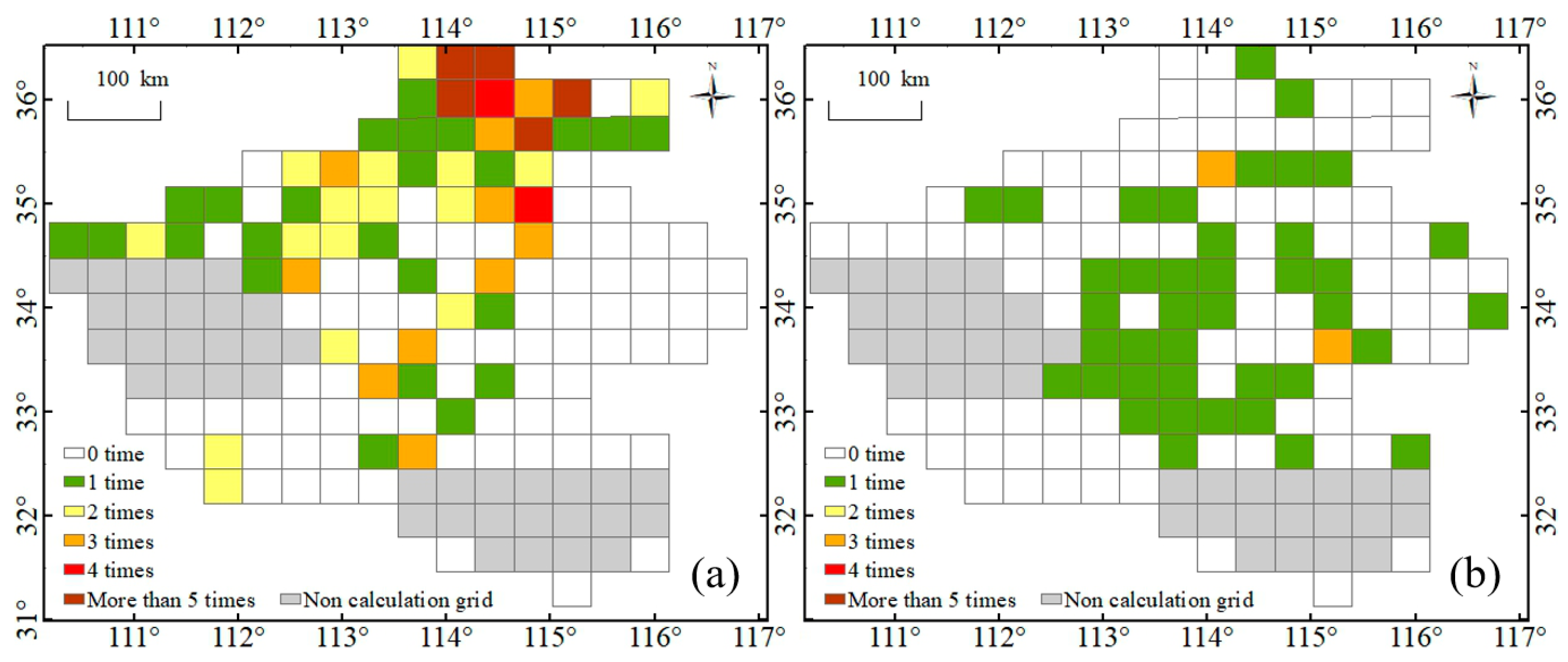
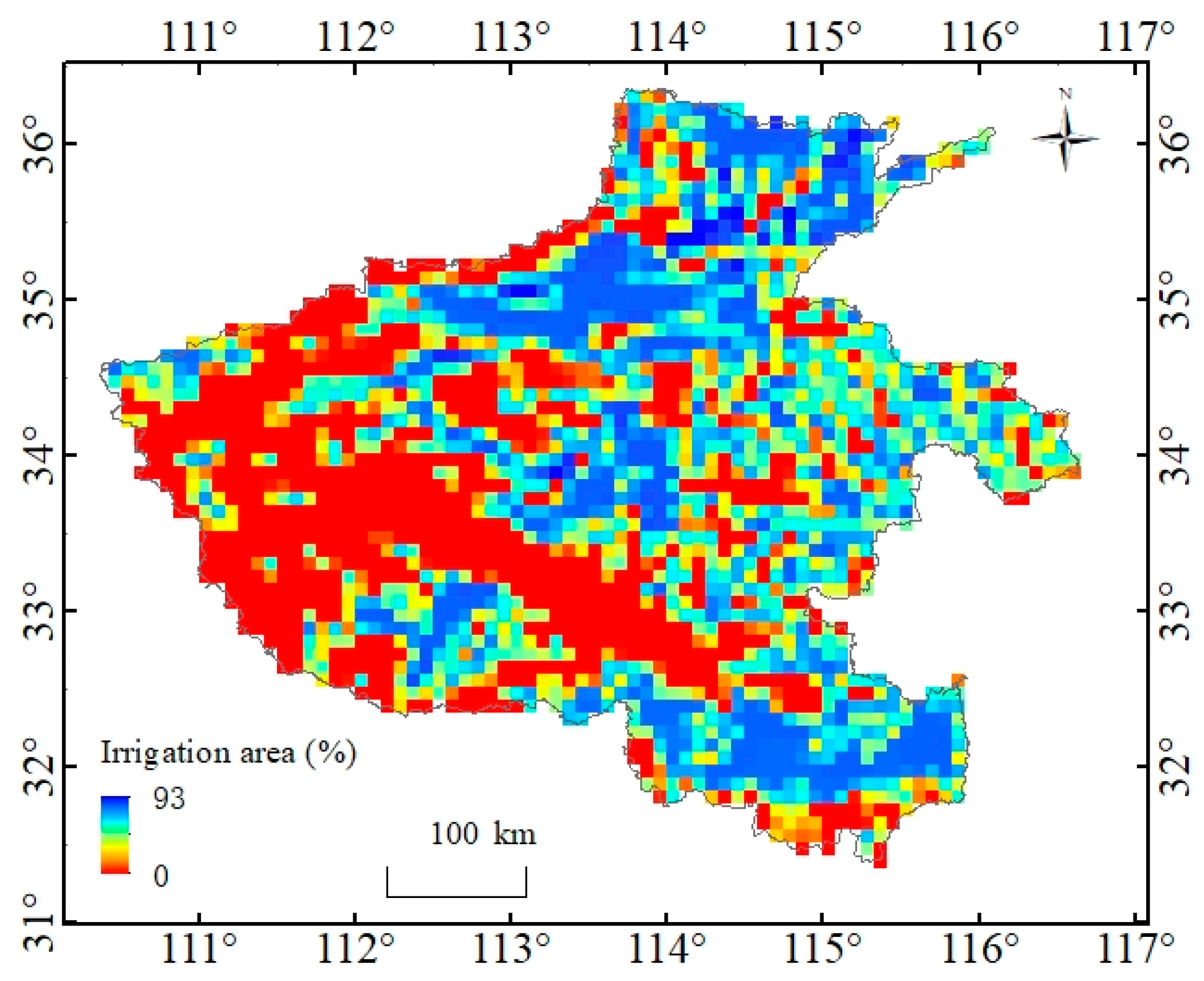

| Study | Soil Moisture Data | Location | Detection/Extraction | Method |
|---|---|---|---|---|
| 1. Kumar et al. (2015) | AMSR-E AMSR2 SMOS ASCAT Simulated soil moisture | Over the continental US | Detection | Compare satellite soil moisture to the model simulated soil moisture that does not simulate irrigation. |
| 2. Qiu et al. (2016) | ESA CCI Soil Moisture In situ soil moisture | Over the mainland of China | Detection | Compare satellite soil moisture to in situ soil moisture. |
| 3. Singh et al. (2017) | AMSR-E | Punjab and Haryana states in India | Detection | Compare satellite soil moisture in irrigated area to that in rain-fed area. |
| 4. Lawston et al. (2015) | SMAP_E | Three valleys in the US | Detection | Compare satellite soil moisture in irrigated area to that in non-irrigated area. |
| 5. Brocca et al. (2018) | SMAP_P SMOS ASCAT AMSR-2 | Nine pilot sites in Europe, USA, Australia and Africa | Detection | Calculate input water by using SM2RAIN algorithm and satellite soil moisture; compare the input water to the observed precipitation data. |
| 6. Jalilvand et al. (2019) | AMSR2 | Miandoab plain in Iran | Detection | Same method as Brocca et al. (2018). |
| 7. Zaussinger et al. (2019) | SMAP_P AMSR2 ASCAT Reanalysis soil moisture | Over the continental US | Detection | Same method as Brocca et al. (2018). |
| 8. Al-Yaari et al. (2019) | SMOS ESA CCI Soil Moisture Reanalysis soil moisture | Over the continental US | Detection | Analyze the link between spatial patterns of summertime satellite soil moisture, precipitation, and air temperature biases in 20 different CMIP5 simulations. |
| 9. Hao et al. (2019) | SMAP_E | Hebei Province in China | Extraction | Extract out irrigation signals by setting precipitation threshold. |
| 10. This study | SMAP_P | Henan Province in China | Extraction | Develop an irrigation signal extraction method that takes into account multiple environmental factors in irrigation. |
| Number | Station ID | Longitude | Latitude | Land Use |
|---|---|---|---|---|
| 1 | 53974 | 114.183 | 35.616 | Irrigated farmland |
| 2 | O2063 | 114.23 | 35.565 | Irrigated farmland |
| 3 | O2647 | 114.171 | 35.553 | Irrigated farmland |
| 4 | O2913 | 114.174 | 35.736 | Irrigated farmland |
| 5 | O2922 | 114.107 | 35.728 | Irrigated farmland |
| 6 | 53990 | 114.315 | 35.715 | Irrigated farmland |
| 7 | 53992 | 114.574 | 35.759 | Nonirrigated land |
| 8 | O2067 | 114.572 | 35.766 | Irrigated farmland |
| 9 | O2068 | 114.322 | 35.492 | Irrigated farmland |
| 10 | O2069 | 114.47 | 35.667 | Irrigated farmland |
| 11 | O2073 | 114.291 | 35.67 | Irrigated farmland |
| 12 | O2850 | 114.42 | 35.58 | Irrigated farmland |
| 13 | O2907 | 114.606 | 35.666 | Irrigated farmland |
| 14 | O2908 | 114.66 | 35.74 | Irrigated farmland |
| 15 | O2909 | 114.441 | 35.811 | Irrigated farmland |
| 16 | O2910 | 114.35 | 35.61 | Nonirrigated land |
| Station (s) # | Observed ## | Threshold 0.6 * | Threshold 0.7 * | Threshold 0.8 * | Threshold 0.9 * |
|---|---|---|---|---|---|
| 1 | 31 | 18 | 16 | 10 | 10 |
| 2 | 16 | 11 | 9 | 6 | 6 |
| 3 | 8 | 7 | 7 | 6 | 6 |
| 4 | 4 | 4 | 4 | 3 | 3 |
| 2016 | 2017 | ||
|---|---|---|---|
| Pixel 1 | Pixel 2 | Pixel 1 | Pixel 2 |
| 58–60 | 44–-45 | 113–118 | 17–22 |
| 95–100 | 50–52 | 132–134 | 25–36 |
| 327–330 | 82–84 | 329–332 | 39–41 |
| – | 90–92 | 345–348 | 65–68 |
| – | 95–100 | 358–359 | 225–228 |
| – | 223–226 | – | 332–335 |
| – | 327–332 | – | 345–348 |
Publisher’s Note: MDPI stays neutral with regard to jurisdictional claims in published maps and institutional affiliations. |
© 2021 by the authors. Licensee MDPI, Basel, Switzerland. This article is an open access article distributed under the terms and conditions of the Creative Commons Attribution (CC BY) license (https://creativecommons.org/licenses/by/4.0/).
Share and Cite
Zhu, L.; Zhu, A.-X. Extraction of Irrigation Signals by Using SMAP Soil Moisture Data. Remote Sens. 2021, 13, 2142. https://doi.org/10.3390/rs13112142
Zhu L, Zhu A-X. Extraction of Irrigation Signals by Using SMAP Soil Moisture Data. Remote Sensing. 2021; 13(11):2142. https://doi.org/10.3390/rs13112142
Chicago/Turabian StyleZhu, Liming, and A-Xing Zhu. 2021. "Extraction of Irrigation Signals by Using SMAP Soil Moisture Data" Remote Sensing 13, no. 11: 2142. https://doi.org/10.3390/rs13112142
APA StyleZhu, L., & Zhu, A.-X. (2021). Extraction of Irrigation Signals by Using SMAP Soil Moisture Data. Remote Sensing, 13(11), 2142. https://doi.org/10.3390/rs13112142







